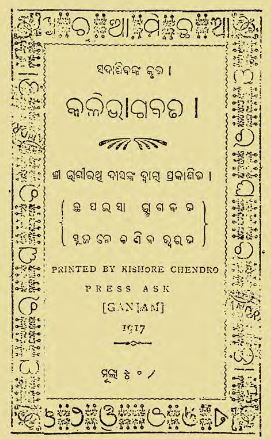In the rich tapestry of Odia literature, “Kalibhagabata,” published in 1917 by the esteemed poet Sadasib Dwija, stands out as a significant work that intertwines spirituality, philosophy, and the essence of life. Dwija, an influential figure in the world of Odia poetry, offers readers a profound exploration of the human experience through the lens of devotion and introspection.
“Kalibhagabata” can be translated as “The Story of Kali,” where “Kali” represents not just the Goddess, but also a metaphor for time, the cycle of life, and the inevitable dance of creation and destruction. Throughout the collection, Dwija intricately weaves narratives that delve into the complexities of existence, embracing themes of sadness, joy, love, and the relentless pursuit of truth. Each poem serves as a reflection of both the inner turmoil and serene acceptance of life’s transient nature, urging readers to contemplate their place within the universe.
The beauty of “Kalibhagabata” lies not only in its thematic depth but also in Dwija’s masterful command over the Odia language. His verses are rich with imagery, metaphors, and rhythmic cadence, making them a delight to read and recite. One can find echoes of traditional Odia folklore, intertwined with personal anecdotes, creating a vivid portrayal of rural life in Odisha during the early 20th century. Moreover, Dwija’s use of symbolism is particularly noteworthy; the goddess Kali often embodies the fierce yet nurturing aspects of femininity, serving as a power source for transformation and resilience.
Dwija’s poetry is marked by an introspective tone, where he grapples with existential questions and delves into the nature of divine presence. Each piece in “Kalibhagabata” acts as a meditative dialogue between the self and the universe. In his verse, readers can feel the weight of his contemplations, as he seeks to reconcile the chaos of the external world with the serenity of the internal spirit. This duality creates a compelling narrative that resonates deeply with anyone who has experienced the ebb and flow of life’s challenges.
Furthermore, the socio-political context in which “Kalibhagabata” was written cannot be overlooked. The year 1917 was a time of significant change in India, with the country poised on the brink of the independence movement. Dwija’s work reflects the rising consciousness among the Odia-speaking populace, as he infuses a sense of pride in Odia culture and heritage through his verses. The poems invite readers to reconnect with their roots, urging them to take pride in their identity and cultural legacy.
In conclusion, Sadasib Dwija’s “Kalibhagabata” is an impressive amalgamation of artistic expression and philosophical inquiry. It remains an enduring piece of literature that continues to inspire subsequent generations of poets and readers alike. Its timeless themes of devotion, existence, and the human condition reflect a universal longing for understanding and connection. As we navigate our own journeys through life, Dwija’s verses remind us of the importance of introspection and the beauty found in the complexities of our experiences. For anyone keen on exploring Odia poetry, “Kalibhagabata” is a treasure trove that demands to be read, experienced, and reflected upon.
Books Info
| Books name | Kalibhagabata |
| Author | Sadasib Dwija |
| No Of pages | 20 |
| Publisher | New H Publishers |
| Publication | 1917 |
| Printed At | Shubham Printers |
| Distributor | NA |

